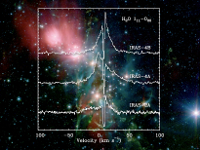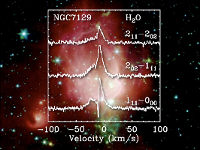Herschel's HIFI follows the trail of cosmic water
6 May 2010
Herschel's HIFI instrument was especially designed to follow the water trail in the Universe over a wide range of scales, from the Solar System out to extragalactic sources. Early results, presented this week at the Herschel First Results Symposium, demonstrate how HIFI uses water to probe the physical and chemical conditions in different regions of the cosmos.Water is an extremely important molecule in the Universe, abundant in a large variety of cosmic environments — from our own blue planet and its neighbourhood, the Solar System, through interstellar clouds where new stars and planets are formed, and even beyond the Milky Way, in star-forming galaxies. Due to the large amount of water vapour present in the Earth's atmosphere, however, astronomical observations of water from ground-based facilities are virtually impossible, even from the driest and highest deserts; they need to be carried out with space observatories.
 |
 |
|
Herschel's HIFI instrument has detected water lines towards low-mass protostars. (Click on the images for further information and credit details.) | |
The presence of water in a celestial object is revealed through its very distinctive fingerprints, or lines, in the object's spectrum at far-infrared and sub-millimetre wavelengths. Only high resolution spectrographs, such as HIFI on board ESA's Herschel Space Observatory, are able to obtain spectra sufficiently precise to track down the abundance of water in great detail.
HIFI, or the Heterodyne Instrument for the Far Infrared, was designed with the quest of water and other molecules very much in mind. Based on the heterodyne detection principle, it basically translates, without loss of information, the high-frequency signal received from astronomical sources to a lower frequency, where measurements are easier to perform. "With its superb spectral resolution, HIFI is ideally suited to detect and characterize molecular lines, and is currently performing a chemical census of the cosmos," says Göran Pilbratt, Herschel Project Scientist.
"Water is an excellent diagnostic tool to probe the chemical and physical structure of the interstellar medium," explains Alexander Tielens from Leiden University. "Early detection of this important molecule on all cosmic scales highlights that HIFI is working extremely well."
With its superb resolution, HIFI can target about 40 different lines, each coming from a different transition of the water molecule and thus sensitive to a different temperature. This plethora of water lines in the spectra is anything but redundant information: it actually helps to overcome one of the natural drawbacks of astronomical observations, which yield two-dimensional images due to the projection on the celestial vault. As each line comes from a slightly different area in the interstellar clouds, putting all the information together gives a three-dimensional view of them. "HIFI data represent a sort of MRI scan through these regions, examining them slice-by-slice in a tomographic approach," explains Frank Helmich, Principal Investigator for Herschel-HIFI.
The role of water is crucial in the processes of star formation, because this molecule contributes to the cooling of the gas and dust mixture from which stars are born. Early results, reported this week at the Herschel First Results Symposium, demonstrate the detection of water in various proto-stellar systems. Along with upcoming data from star-forming clouds throughout the Milky Way, these data will help astronomers understand the mechanisms of star formation in great detail. Beyond our Galaxy, water signatures have been found in nearby galaxies which are known to be undergoing intense bursts of star formation.
Water trails go all the way from vast star-forming clouds down to stars and planets on much smaller scales. In the proto-planetary discs surrounding stars in the process of forming, water vapour may in fact freeze onto dust grains; these cold grains would then condense into icy planetesimals, the seeds of planet formation.
"In our very own planetary system, HIFI has observed a handful of comets, which are dusty conglomerates held together by icy water," notes Tielens. These cosmic 'ice balls' are living fossils in the Solar System, since they spend most of their lifetime at its boundaries and their chemical composition closely reflects the pristine conditions when the planets were formed about 4.5 billion years ago. "Further analysis of these early data collected by HIFI will shed new light on the early history of the Solar System," Tielens adds.
Notes for editors:
Herschel is an ESA space observatory with science instruments provided by European-led Principal Investigator consortia, with important participation from NASA.
HIFI, a high resolution spectrometer was designed and built by a nationally-funded consortium led by SRON Netherlands Institute for Space Research. The consortium includes institutes from France, Germany, USA, Canada, Ireland, Italy, Poland, Russia, Spain, Sweden, Switzerland, and Taiwan.
The distribution of water and its related species is the primary focus of the Key Programme WISH: Water In Star-forming regions with Herschel, led by Principal Investigator E.F. van Dishoeck. This programme is dedicated to studying the physical and chemical structure of star-forming regions through combined HIFI and PACS spectroscopy.
Other HIFI Key Programmes with a water theme are: HIFISTARS, led by Principal Investigator Valentín Bujarrabal, which studies the role of water in the ejecta from stars in the latest stages of their evolution when they return most of their material back to the interstellar medium; HSSO, led by Principal Investigator Paul Hartogh, which studies the role of water in Solar System objects, in particular Mars, the giant planets and comets; and HEXGAL, led by Principal Investigator Rolf Güsten, which among other things follows the water trail on a galactic scale in nearby galaxies.
Contacts:
Göran Pilbratt, Herschel Project Scientist
Research and Scientific Support Department
Science and Robotic Exploration Directorate, ESA, The Netherlands
Email: gpilbratt rssd.esa.int
rssd.esa.int
Phone: +31-71-565-3621
Alexander Tielens, HIFI Project Scientist
Leiden University, The Netherlands
Email: tielens strw.leidenuniv.nl
strw.leidenuniv.nl
Phone: +31-71-527-8465
Ewine van Dishoeck, Principal Investigator of the WISH Key Programme
Leiden University, The Netherlands
Email: ewine strw.leidenuniv.nl
strw.leidenuniv.nl
Phone: +31-71-527-5814
Frank Helmich, Principal Investigator for HIFI
SRON Netherlands Institute for Space Research, The Netherlands
Email: F.P.Helmich sron.nl
sron.nl
Phone: + 31-50-363-8320
Mobile phone: +31-6-49423644

